Cure any ailment! Never known to fail! Early medicine adverts made grand claims but they look alarming today
by Emma Beddington, pictures selected by Sarah Gilbert
Tue 7 Nov 2023 05.00 EST
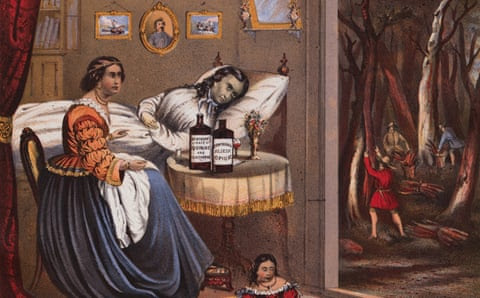
The confusion with patent medicines starts with the name, since they were rarely ever patented; manufacturers just thought it sounded cool. Bamboozling was always part of the package: from the 17th century, concoctions of water, alcohol and herbs were sold with wild claims and exotic origin stories. In the 1630s, Anderson’s Pills were hyped with dubious claims that the recipe came from Venice and Anderson’s close ties to the King. By the 18th century, there were liniments, wafers, unguents and tonics confidently proclaiming they would cure whatever ailed you.
Indeed, claiming to cure everything – from “generalised debility” to “chafing”, “lassitude” to “weak stomach fibres” – was key to patent medicines’ success. Before anaesthesia and antibiotics, the distinction between quack and “proper” medicine was blurred anyway: why not fall for the seductive claims of a herbal panacea when your doctor is threatening blood-letting?
Mass production and the media supercharged patent medicines in the later 19th century, particularly in the US, where they became big business. The advertising industry cut its teeth and developed its creativity on them: ads were everywhere and travelling shows took quack medicine live. Attention-grabbing colour-printed trade cards were particularly popular, luridly playing on fears and aspirations and confirming prejudices. Women were presented as ethereal, feeble simpletons (and “unfeminine” behaviour such as having an opinion could be cured with the right elixir), and racist imagery, particularly of Native Americans, was used to make potions appear “exotic”, authentic and ancient.
The remedy was often worse than the disease. Notoriously, many cures contained opiates and cocaine; they were often also targeted at children and babies and contained life-threatening percentages of alcohol. Colden’s Liquid Beef Tonic – advertised to treat alcoholism – was 26.5% ABV; a similar product, Parker’s Tonic, advertised as “purely vegetable”, was an eye-watering 41.6%. There is no reliable estimate of how many people – particularly children – patent remedies killed, but “lots” seems a safe bet.
Did any work? Plenty contained effective (excessive) opiate analgesia; simpler formulas could be effective for indigestion or iron deficiency, and the placebo effect must have been powerful. A PhD thesis on Georgian medicines argued that it is anachronistic to assess historical remedies with our contemporary understanding of ingredients and efficacy. Perhaps that’s right? It’s easy to sneer at the unscrupulous peddling of snake oil to the credulous, but who are we, in our era of horse-wormer Covid cures and TikTokkers drinking borax to judge? Counter-argument: you really shouldn’t give teething babies opium.
I need to get back to tinkering with Dr Beddington’s Tincture for Moral Degeneracy, so let’s dive in. Warning: side effects may include temporary blindness, hallucinations and hairy werewolf palms.
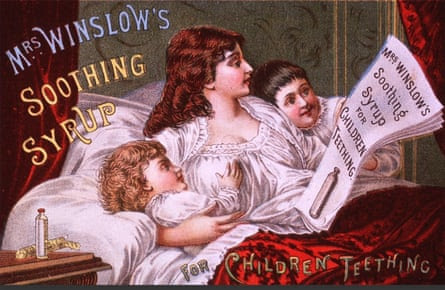
Mrs Winslow’s soothing syrup
‘Baby killer’ … a 1910 ad for Mrs Winslow’s Soothing Syrup. Photograph: Pictorial Press/Alamy
You could make an educated guess at the active ingredient in baby nurse Charlotte Winslow’s syrup just looking at these infants’ eyes. Its 65mg of morphine per ounce (plus alcohol) is believed to have been a significant cause of infant mortality – 1.5m bottles were sold annually, according to an 1868 court summons – and it was condemned by the American Medical Association in 1911 as a “baby killer”. .
Pink Pills for Pale People

Dr. Williams’ Pink Pills for Pale People from 1910.
Glow up … Pink Pills for Pale People. Photograph: Smith Collection/Gado/Getty Images
A Pale Person myself, I yearn to gambol, rosy-cheeked, through flowery meadows carrying aloft a gigantic tube of my ferrous salvation; you don’t get that from sachets of Spatone Liquid Iron that taste like rusty nails. There are plenty of English-language ads for Pink Pills, which were created in Canada in 1886 and were sold in the UK until the 1970s, but this one is so bursting with art nouveau je ne sais quoi it demanded to be included.
Asthma cigarettes
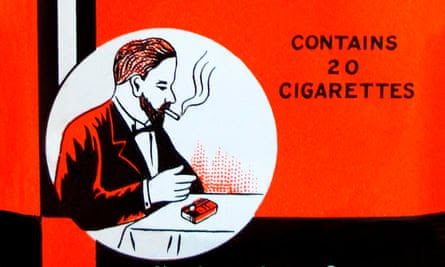
Kelloggs Asthma Cigarettes
The cigarettes were essentially psychotropic drugs from the nightshade family – the ‘Asthma Relief’ contained both lobelia and stramonium. Photograph: Buyenlarge/Getty Images
Listen, I know what you’re thinking, but what if I told you asthma cigarettes included anti-spasmodic ingredients such as stramonium, which means they were basically like an old-timey inhaler? Still no? How about if I tell you that Proust was a fan? Oh, he was a lifelong invalid and died at 51? Fair point.
Hunt’s Remedy
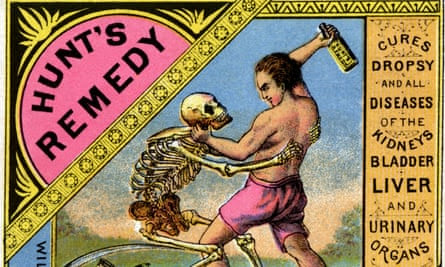
Hunt’s Remedy ad from late 19th c
‘Never known to fail’ … Hunt’s Remedy. Photograph: Buyenlarge/Getty Images
There’s some powerful “not today Satan” energy on display in this late 19th-century trade card: Death picked the wrong guy in tiny pink shorts. Colour was one of patent medicine’s secret weapons – colours on packaging were often touted as proof of authenticity and ads were bright and detailed – and Hunt’s has gone all in, to winning effect. They should put this image on those fancy £8 boxes of matches; they’d sell like hot opium-laced wafers.
Dr Thomas’s Eclectric Oil
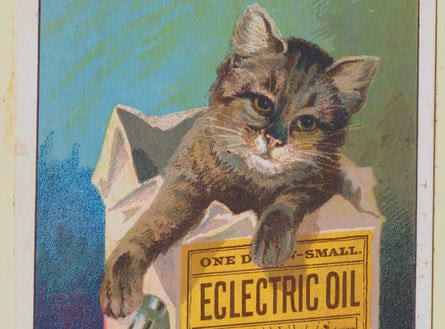
The late 19th Century advertisement for Dr. Thomas’ Eclectric Oil.
Curiosity killed the cat … a 19th-century advert for Dr Thomas’ Eclectric Oil. Photograph: Bettmann Archive
Nothing says “science” like an entirely made-up word (capitalising on the 19th-century American fascination with electricity, apparently). Patent medicines were often marketed for animals as well as humans and why not? One of my relatives shared anti-epileptics with the family dachshund. Though this kitten looks pretty bleary: “alcohol, chloroform … tinctures of opium … hemlock, and turpentine” will do that, I suppose.
Ayer’s Ague Cure
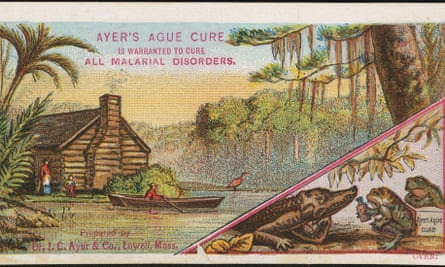
Ague Cure ad late 19th c
Thankfully, the ‘cure’ did contain quinine. Photograph: Hi-Story/Alamy
“An ailing alligator is given a bottle of the Ague Cure by two concerned-looking frogs,” reads the Wellcome Collection’s unimprovable description of this ad. The Ague Cure boasted of not containing quinine, rather unfortunately for a malaria treatment. Thankfully, that was a lie: it did contain quinine.

Hamlin’s Wizard Oil ad
Chaos in a bottle … Hamlin’s Wizard Oil. Photograph: Alamy
This is compelling, but confusing. The circus elephant has stolen the Wizard Oil, OK, but why is someone painting the slogan on its rear, and who are the nattily dressed men with wind instruments? What’s happening on the roof? Admittedly Hamlin’s was 50-70% alcohol plus ammonia and turpentine, so the world would probably look like this chaotic clown show if you drank it.
Pond’s extract ad
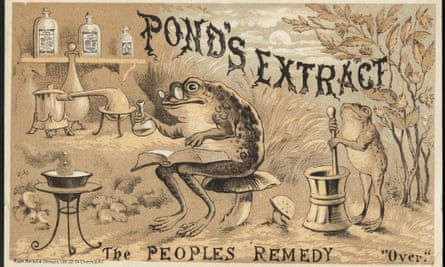
Pond’s extract was one of the first commercial products to contain witch hazel. Photograph: Hi-Story/Alamy
More frog medics, a recurring – and welcome – theme in patent medicine advertising. I would absolutely buy whatever this very professional-looking duo is brewing up, or I would have done until a friend theorised it was “their own back secretions”.
Dr McMunn’s
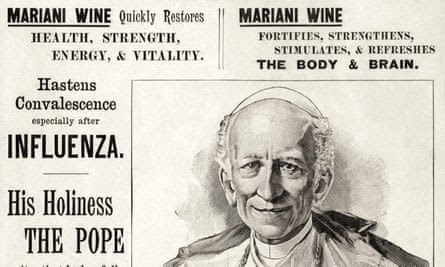
Advertisement for Quinine as medication from the 1860s.
‘In Fluid Form and Always Ready for Use’ … an 1860s advertisement for the quinine and opium-based tonics. Photograph: Bettmann Archive
The vibe on this 1860s ad is very off: the grey, deceased-looking invalid is a terrible advert for the Dr McMunn’s products on her bedside table. She’s being nursed by what appears to be Spanish Monkey Christ in a crinoline – no wonder it’s going badly – and there are far too many animals and children knocking around this apparent deathbed. The men outside are harvesting quinine and cinchonine, the active ingredients; I fear it’s a bit late for that.
Vin Mariani
An endorsement for Mariani Wine from Pope Leo XIII.
Fit for a Pope … Mariani Wine tonic. Photograph: Contraband Collection/Alamy
This is not just cocaine wine; this is Pope-approved cocaine wine. Leo XIII lived to 93 thanks, arguably, to a hip flask of Vin Mariani tonic wine (the “tonic” was 6mg of coca leaf). Mariani was wildly ahead of his time, marketing-wise: he sent samples to celebrities requesting testimonials, which he then published. Vin-fluencers included Presidents William McKinley and Ulysses S Grant and Pius X: yes, that’s two popes and two presidents. Chapeau.

Leave a Reply